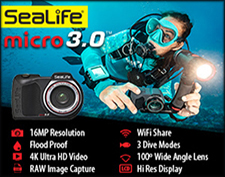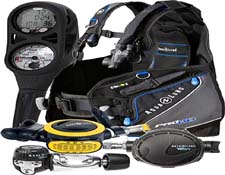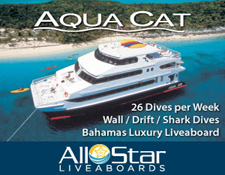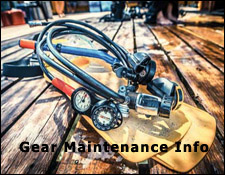

|


|
 |
 |
 |
 |
 |
 |
 |
 |



 Location & Geography Ecuador straddles the Equator at Latitude 0, occupies a wedge-shaped area on the northwest Coast of South America. It is bounded on the north by Colombia, on the east and south by Peru, and on the west by the Pacific ocean. The Galapagos Islands are located in the Pacific Ocean, about 620 miles west of the Ecuadorian coastline and along the equator. The islands are of volcanic origin and sit at the junction of the Nazca and Cocos tectonic plates. 13 major islands, 16 islets and 47 rocks, with a total population of 10,000 inhabitants form this unique archipelago where rare ecosystems of unusual flora and fauna co-exist. They cover a surface area of approximately 12,798 sq. miles. Over half this area corresponds to Isabela Island. Some of the smaller islands are borderd by huge cliffs and cannot be accessed from the sea. The acumulation of coral and sea shells on beaches of others, gives the shorelines a special luminosity which stands out from the surrounding turquoise green ocean set against the dark background of volcanic rocks. These "Enchanted Isles" attained world fame after the English naturalist Charles Darwin conceived his Theory of the Origins and Evolution of the Species while visiting there. They are named for the giant tortoises that inhabit the islands. The Charles Darwin Research Institute was created in 1959 on Santa Cruz Island. The station is in charge of research regarding the endemic species of the islands and plays an important role in the administration of the National Park. Because of its unique flora and fauna, UNESCO has proclaimed the Galapagos Islands "Natural Patrimony of Mankind". Volcanic activity gave rise to the Galapagos approximately 3 million years ago. Evidence of current vocanic activity can be seen on Isabela and Fernandina Islands, both of which have volcanos which are still smoking. As one sails from east to west, one encounters progressively newer islands. The volcanic activity is characterized by constant stream of molten lava gradually gliding down to the sea, rather than by sudden violent eruptions. The highest peak in the islands is Cerro Azul on Isabela (14,800 ft from the ocean floor). Near Floreana Island is a sunken crater, with peaks along its circular rim sticking out of the ocean and dubbed The Devil's Crown. Principal Regions Quito At one time, the present capital of Ecuador was also the capital of the Kingdom of Quito and of the northern part of the Incan Empire (Chinchaysuyo). It has been destroyed and rebuilt many times through the centuries. Even so, the city's architecture continues to show the splendor of the Latin American baroque along with its Spanish and Flemish influence. The city displays the best of the Quito School of Art (17th and 18th centuries) in its churches, monasteries and museums. For this reason, the UNESCO has declared Quito a "Cultural Patrimony of Mankind". And Quito is fun, enjoying fine hotels, restaurants, casinos, shops and street markets. Quito's setting is jewel-like, set in the Andean highlands where tiny villages cling to the steep mountain slopes. Roads lead north and south to colorful Indian Markets (Otavalo, Ibarra, Ambato, Latacunga, Saquisili, Latacunga and Pujili to name a few), and to dramatic volcano landscapes in the nearby provinces of Imbabura, Tungurahua and Chimborazo. Guayaquil The largest city in Ecuador, Guayaquil, is a lively Pacific coast port, but actually inland on the Guayas River Delta. The city has a noble past and a dynamic present as the economic center of Ecuador. Color is everywhere; in the street markets, in the harbor, bustling with boats carrying tropical fruits, fish and other produce. This is an ideal gateway to the beaches of Ecuador that stretch north to Esmeraldas, as well as jump-off points to sites of recently discovered Indian cultures that are proving more ancient than anyone imagined. Cuenca The third largest city in Ecuador, Cuenca has preserved its colonial ambiance in its cobblestone streets, historic mansions and religious art treasures. Inca ruins have been found on the city banks by the Tomebamba River, and the vast fortifications and temples of Ingapirca, the most northerly major Inca site, is an hour away from the city. Cuenca is Ecuador's capital of crafts, on display in the stores and made by hand in the neighboring villages. The Imbabura Province Otavalo - Situated in the rugged lake district, nearly 8,530 feet above sea level. This high-altitude valley is often sunny and warm. The landscape is made up of a patchwork of small gardens, cerulean lakes, and plowed and fallow field. Over the picture-book landscape rise the craggy peaks of three now extinct volcanoes - Imbabura, Cotacachi, and Cayambe. Famous for its market which operates from Wednesday thru Saturday. Although tourist oriented, the market is still a remarkable event - beautiful and self-assured Otavalenas crowd the stalls and stands, surrounding the plaza, selling piles of woolen and cotton sweaters; traditional and modern ponchos; tapestries, rugs, and wall hangings; antiques; and sterling silver and alpaca (nickel silver) jewelry imbedded with Andean jade, lapis lazuli and other semiprecious stone. San Pablo Lake - deep blue lake offering an unobstructed view of Imbabura Volcano. Cotacachi - famous for leather, proffering jackets, skirts, shoes, purses, and luggage of respectable quality. Cuicocha Lagoon - A nearly circular lake cradled in a crater on the lower flanks of an extinct volcano. Marked hiking trails meander along the crater's rim, giving good views of the Imbabura and Cayambe volcanoes and Chile. San Antonio de Ibarra - Wood carvings center Calderon - renowned for bread doll figures Peguche - famous for Andean weavings The Amazon Basin and Its Flora & Fauna overing approximately 46,332 sq. miles, the major area of the Ecuadorian Amazon supports exuberant vegetation that is typical of humid tropical forests. Its western limit is the Andes Mountain Range, Peru lies to the south and Colombia to the north. Immense quantities of material flowing from the Andes have been washed down the rivers, forming strips of alluvial soils and terraces that are used for farming. The principal Amazon artery for visitors is the Napo River, a major tributary of the main Amazon River. Its basin is 870 miles long and one to three miles wide. As a result of fluvial dynamics, the Napo's 130 islands are covered by young forests, which provide refuge and nesting sites for a multitude of bird species, many of them migratory. Along the length of the Napo, natives and settlers have established communities, interspersed occasionally with small hotels and lodges. Most of the shore is covered with tropical forest, and over thousands of years, riverbeds have formed many attractive lakes. Historically, the indigenous communities have been able to maintain a productive subsistence within the existing ecosystems of vast forest preserve. The most representative are: the Siona-Secoya, Cofan, Huaorani, Quichua, Shuar and Ashuar. The Amazon ecosystem, particularly its tropical rain forest, is considered to be one of the richest and most complex communities of plant and animal life in the world. The region is characterized by huge and diverse amounts of flora and fauna with extraordinary variations in their habitats and micro-habitats. The principal attraction of the hilly forest is, of course, the trees, some soaring higher than 150 feet. Common species are cinnamon, silkcotton, jacaranda and several leguminous trees. The alluvial plains, located on the terraces of the principal rivers, support great concentrations of palm trees. In the jungles of the Upper Amazon, 100 species of trees per acre have been recorded. In Central America, only u to 40 species per acre have been discovered. In the temperate forests of North America and Europe, rarely more than 20 different species exist per acre. The Amazon's rivers, lakes, streams and marshlands support over 600 species of fish and more than 250 species of amphibians and reptiles. The lagoons of the Napo and Aguarico River basins are home to colonies of two species of caymans that grow to over 13 feet in length. Typical South American mammals which live in Ecuador's Amazon include armadillos, honey bears and sloths. Amazon bats form a cosmopolitan group numbering more than 60 species. Other mammals found in the tropical forest include tapirs, monkeys, and ocelots (or jaguars). On a walk through the forest, you will observe groups of monkeys, boars and large rodents; and in the lagoons there are manatees and caymans. Birds are the richest group of Amazon vertebrates, and approximately 1,000 species live in a variety of forest habitats, lagoons and open areas. In all Amazon ecosystems, colorful birds make themselves at home. Familiar sightings will be parrots, macaws and tanagers on land and on water, darters, herons and gulls flourish. The Galapagos Islands and Its Flora & Fauna The unique flora and fauna of the Galapagos is renowned for its diversity and because the islands constitute a natural laboratory in which the evolution of the species through natural selection can be studied. Each island has its own endemic species and many of these are not found anywhere else on earth. The reptile, bird and marine life of the islands is extremely rich. However, due to the rocky nature of the islands, only spiny or very spindly vegetation grows in the lower altitudes. On recent lava flows, there is no vegetation at all. Trees that grow below 660 ft. have only few small leaves. On the foothills, there are algarrobos (carob trees), and bushes known as palo santo. The larger dry plains have giant cacti. Above 660 ft., temperatures are cooler, there is more humidity, and vegetation becomes thicker and greener. There are many guayaba (guava) trees and citrus trees, both introduced from the continent. All the islands have their own endemic plants as well as those common to several islands which were generally introduced by man. Population The population of Ecuador & its Galapagos Islands is approximately 12 million. It is difficult to establish an exact distribution of the different ethnic groups due to mixtures of White, Indian and Black races. There are 10 Indian nationalities, each one with its distinctive language and customs, making Ecuador a fascinating multi-cultural land. Guayaquil is the most densely populated city in the country (2 million approximately), followed by Quito (1.5 million) and Cuenca (750,000). Religion Although the Catholic religion is predominant, churches of many faiths are found throughout the country. Political System According to its Constitution, Ecuador is a democratic republic divided into three branches of government; Executive, Legislative and Judicial. The republic is made up of 21 provinces with Quito as its capital. The President and Vice President of the Republic are elected to 4 year terms by universal vote. The Legislative branch of the government is the Congreso Nacional, composed of national and provincial deputies elected in proportion to the population. With the exception of the Province of Pichincha, all the governors of the provinces are appointed by the Ministerio de Gobierno. Economy During the 1970's, oil exports represented more than 50% of Ecuador's foreign income. Recently, more traditional exports such as banana, coffee, cocoa, shrimp, tuna fish, canned tropical fruits, etc have become important. Due to Ecuador's many and varied attractions, tourism is one of the top three national revenue producing products in the 1990's. Communication Direct dial telephone communications and telex are available in the principal cities, as well as satellite and VHF television connections. There are over 40 newspapers (almost all in Spanish). Language The official languages in Ecuador are Spanish and Quechua, the language introduced by the Inca and still spoken by indigenous peoples in both the highlands and the Amazon. English will be spoken by all our representatives. Most hotels, restaurants and shops also have English speaking personnel, but do not expect 100% fluency. It is advisable to carry a English/Spanish Phrase book with you. Currency Click Here For Currency Exchange The local currency is Sucre and exchange rates vary but the best rates are obtained at hotels and local banks. There are 100, 500, 1000, 5000, 10000 Sucre bills. There are also 1, 5, 10, 20 and 50 sucre coins. (Exchange rate on December 11, 1996 - $1 = 3,600 Sucres). When exchanging money, please obtain a receipt. Best rates usually obtained at exchange houses or banks. Bank Hours Generally 9.00 am - 1.30 p.m. Monday through Friday. Forms Of Payment Visa, Diners Club, Mastercard, and American Express are widely accepted (especially the first three). A few businesses add a surcharge of 3% - 10% on credit-card transactions. Time Zone Ecuador is in the Eastern Standard Time Zone. Daylight savings time is not observed. Galapagos is 1 hr behind Ecuador Mainland. Most Galapagos Vessels however maintain Ecuador Mainland Time. Electricity Throughout Ecuador - 110 VOLTS, 60 CYCLES AC. In the Galapagos - some vessels in the Galapagos have both 220 volts and 110 volts. Adaptors for recharging camera batteries are available in the major hotels and on some vessels operating in the Galapagos. Laundry Facilities Laundry can be done at the major hotels at the appropriate charges imposed by the hotels. There are no laundry facilities in the Amazon, Galapagos, or on your vessel. Smoking We suggest that passengers refrain from smoking in public areas, sightseeing vehicles and when aboard the Galapagos vessels - in the cabins, the dining area, or community areas. There are designated areas for smoking on your vessel. Smoking is prohibited on the islands (except in the ports of Puerto Ayora or Puerto Baquerizo Moreno). Please do not throw cigarette butts over board, as this is harmful to the environment. Shopping & Souvenir Items Shops are open from 9.00 am to 1.30 pm, and from 3.00 pm to 6.30 pm. Few shops stay open at lunch time. Please ask our representative for recommended shopping streets and stores. Jewelry, antiques or artwork at specialist stores are the usual purchase trend. Shopping is best in QUITO. Woolen weavings can be found in a variety of items (ponchos, cushions, bags, floor rugs). Leather work items range from full suits to coin purses and wide-brimmed hats. Items made of Balsa wood in the jungles of the Amazon are very popular. Tagua nut carvings are typical of Ecuador. Embroidered blouses, straw baskets and pottery can also be purchased. Panama hats made from a palm-like bush which grows abundantly in the coastal province of Manabi are worth buying. Bargaining with street vendors or at native markets is okay. Bargaining in city shops could turn out to be embarrassing and perhaps offensive. Major credit cards, travelers checks and cash are accepted in the major cities. Personal checks are not accepted. Trading may be done in U.S. Dollars or Ecuadorean Sucres. Dirty, tattered or torn US bills are not usually accepted. Climate Ecuador's climate is strongly influenced by ocean currents, trade winds, and altitude, which make generalization difficult. December - May: Temperature Range from high 70's to low 90's. Rainy season throughout most of Ecuador. However, during this time, Guayaquil is also hot & muggy. Quito experiences spring like climate with short bursts of rain in the afternoon. Cuenca, Cotopaxi, Riobamba, Otavalo, and other cities located in the highlands of Ecuador are more or less the same as Quito. They may vary a little bit to the lower side. A good sweater is necessary if your travel arrangements include these cities. Galapagos is hot & humid with frequent afternoon showers. This time is also the best time to travel to the Galapagos due to warmer water temperatures. The climate of the Galapagos Islands is influenced by the location along the equator, the cold Humboldt ocean current flowing up from Antarctica, the annual El Niño climatic phenomenon and the mountains of the larger islands which trap moisture from the prevailing ocean winds. However, the islands are very dry due to hard, impermeable basalt and the equatorial heat. Water Temperatures: December through May Averages 75 F Warmest and most ideal for diving February to April June - November: Temperature Range from low 60's to high 70's. Cooler & drier in Ecuador and the Galapagos almost everywhere. Best time to travel on Ecuador mainland. In the Galapagos, strong south easterly winds usually present between July & October. Rougher seas present in September & October. Some fog and mist. Water Temperatures: June through November Averages 70 F Coldest in August and September Please remember that in Ecuador, sun rays strike directly, therefore be very careful when exposing yourself to the sun. In the Amazon, the annual average temperature falls between 76 F and 78 F. Between 118" and 157" of rainfall are distributed more or less equally throughout the year, although December through February are the drier months. Health As for every trip you take abroad, general good health is required. If you are under medication, be sure to bring enough of your medicine for the length of your trip. If you should become ill during your visit, first contact the nearest available doctor. Currently, no immunizations are necessary for your trip to Ecuador, however consult your personal physician. Due to high altitudes in many parts of Ecuador, travelers with heart conditions or high blood pressure should check with their doctors. Recommendations Do not drink tap water anywhere. Do not drink your beverages with ice (only on board the Galapagos vessels and in recommended restaurants and hotels you can do so if you wish). Always drink bottled mineral water and soft drinks (diet soft drinks are not always available). Try to avoid eating raw vegetables and salads, or any raw foods while traveling in the continent. Always choose cooked food. If you wear prescription glasses or contact lenses, it is advisable to bring an extra pair or cleaning fluid. In Quito, due to the altitude, we recommend that you only eat light foods the first day or two, and not to consume alcohol. You may suffer some digestive problems, light dizziness or headache. Sudden dietary changes, from your daily consumption in the U.S.A. to the exotic dishes of Ecuador, especially on the first day or two, may result in digestive problems, often leading to headache, nausea, vomiting and diarrhea. Please be careful. Sightseeing Safety Tips When visiting Quito, or any other city, be sure to watch your purse and wallet. It is best to take in your backpack or fannypack, only the indispensable. Do not take with you all your money or your passport and airline tickets. Always leave these documents and other valuable items in the hotel safe. Take a copy of your documents and only the amount you think you will need. Ask your guide for information on current prices for your shopping. Never leave your luggage or cameras unattended. Always keep them with you or leave them under the supervision of your guide. Tipping Suggestions Tipping is customary in hotels, restaurants and service establishments. Although a service charge is added to your bill (usually 10%), an additional 5% of the bill may be added at your discretion. $5 - $7 per person per day for services rendered by any licensed guide. $2 - $4 per person for services rendered by driver. Galapagos Crew: $15 - $ 20 per person for entire crew (not guides) if you are on a 3 nights cruise. $20 - $ 25 per person for entire crew (not guides) if you are on a 4 nights cruise. $30 - $40 per person for entire crew (not guides) if you are on a 7 nights cruise. Amazon Lodge Staff (not guides): $15 - $20 per person for your overall stay Tips for Galapagos Crew or Amazon Lodge Staff will go in a tip pool. Envelopes or a gratuity box will be available for your convenience. Tipping for other services such as bellboy, chamber maids, etc is voluntary. Additional porterage is at your discretion. We suggest $1.00 per piece of luggage portered. All checked luggage is done at passenger's risk. Entry Documents For Ecuador A valid passport and onward bound ticket is required by each passenger. Passports should be valid for at least 6 more months after your departure to Ecuador. Visitors may stay upto 90 days. Visa are not required by U.S. citizens at time of writing (December 11, 1996). Should this change between now and time of travel, application forms and instructions will be supplied to you by Big Five Tours and Expeditions. Persons not holding an American Passport should contact their local Consulate or Embassy for instructions. Bring photocopies of your passport plus personal photos in case you lose or misplace it during your trip. Taxis And Auto Rental Taxis are available everywhere in the country. Rates vary according to distance and in major cities, cabs have a taximeter. If not, negotiate a rate before entering the cab. Car rental services are also available in the major cities, but be fore-warned of reckless drivers. Driving is on the right as in the U.S.A. Most highways are 2-lane. Taxes To Be Paid Locally - Very Important Galapagos National Tax - $80 per person (Child under 12 - $40 per child). Pay at either Quito, Guayaquil or Galapagos Airports. Obtain a receipt. Local airport tax of approximately $1 per person is paid when checking in for local flights at any Ecuador airport. Passengers arriving at San Cristobal Airport, Galapagos - $30 San Cristobal Port & Municipal Tax paid at National Park Booth + $12 Santa Cruz Port & Municipal Tax collected on the vessel. Total - $42 Passengers arriving at Baltra Island, Galapagos - $12 Santa Cruz Port & Municipal paid at National Park Booth. International Departure Tax - $25 per person payable at Quito or Guayaquil Airport when exiting the country on an international flight. The above fees are payable in cash in US Dollars or Ecuadorian Sucres. Be sure you have the exact change. All taxes correct as of December 11, 1996 but subject to change without notice. Things You Should Know About The Galapagos Landings on the various islands are by flat-bottomed motorized dinghies or rubber pangas, and can be wet or dry. Dry landings would mean stepping directly from the motorized boats onto slippery rocks or sandy beaches, while wet landings would require wading a few feet from the boat to the shore. The water is usually ankle-deep in this case. Once on the islands, you must stay on the marked trails and follow instructions from your guide. Walking or hiking conditions on some of the nature trails, while not extreme, may well require negotiating natural obstacles such as rock strewn hillsides. Such exertions usually end in magnificent views that are well worth the efforts taken. We all know that sea lions, tortoises, lizards and other fauna are cute and welcoming, especially on the islands. The lack of predators and little influence of man has enabled the wildlife to be fearless. However, we ask that you do not touch any of the animals or take anything from the islands. Do not litter at all, either. Leave nothing behind but your footprints. Any direct contact by man in this habitat where elements of nature co-exist can lead to adverse effects on the ecology. Please, we ask that you obey all rules of nature. A Note On Public Conduct In general, one is struck by the good will and hospitality of all Ecuadoreans. None the less, common sense is essential in guiding a visitor's conduct as crime and hostility do exist here, just as they unfortunately exist anywhere else in the world. One simple precaution is to avoid the ostentatious display of one's wealth in the form of fancy camera equipment, jewelry, large wads of bills, etc. But despite a recent increase in violent crime in the largest cities, Ecuador as a whole remains among the safest and most relaxed countries on the entire South American continent. In addition to looking out for one's own safety, the conscientious guest in this generous land has the obligation to treat his hosts with respect and courtesy. Ecuador and its people have much to offer the visitor and the visitor should be willing to offer something of himself (beyond mere financial compensation) in return. An effort to speak the local language, no matter how rudimentary, is always appreciated for example; as are good manners and discretion in the use of ones's camera. Above all, one must remember that it is the polite guest, in a country no less than in a private home, who is obliged to learn from and adapt to the ways of his hosts, rather than expecting that his own customs should prevail. Travel necessitates being a good-natured realist as well as a romantic, and requires an agreeable acceptance of situations as they exist, not as each of us might prefer them to be. A pleasant tolerance makes for an enjoyable travel experience. If you are this appreciative traveler, we want you with us because we know you'll be a wonderful companion and have the time of your life. Note On Amazon Jungle Touring The Amazon programs are not for those who demand luxury. The accommodations that we feature are fairly rustic yet comfortable. Our objective will be explore this diverse eco-system. Although we may hear many animals and birds, we may not see them easily, due to the heavy jungle growth. The jungle animals are generally shy. Sightings of wildlife cannot be guaranteed. One must be reasonably fit to enjoy the jungle at its fullest. Since our accommodations are entirely built of jungle material, including all the furnishings, occasionally small jungle residents such as beetles, forest rats, or cockroaches may crawl in. Please do not find this unacceptable since you are in the jungle and in completely natural surroundings. Keep in mind they are just passing through. We are encroaching on their territory. It is impossible to fumigate since this would be harmful to the fauna and flora of the forest. Big Five Tours strives to bring you as close to nature as possible. This is a once in a lifetime experience that is second to none. Guests expecting to learn about the Amazon and share a sense of humor will enjoy these excursions. This is not the trip for guests demanding luxury, pampering, no bugs, or sophisticated infrastructures. Clothing & Other Packing Suggestions The emphasis should be on comfort. It is best to dress accordingly. Sports clothes for the day. Clothes should be washable and loose-fitting. Cotton or cotton-synthetic combinations are preferable to pure synthetics which retain heat. A light nylon wind breaker may come in handy early mornings or late afternoons. We suggest you bring the following for your overall stay in Ecuador. In addition, we have also provided additional packing suggestions for special regions such as the Amazon and the Galapagos, that you may be visiting. Clothing Items Sweater (Heavy sweater recommended for the highlands) Well-insulated wind breaker Walking shoes, sneakers, or sandals (ideal for the coastal cities and the Galapagos Islands) Long and short sleeved shirts Blouses and T-shirts / tank tops (ideal for the Galapagos) Sturdy long cotton pants, jeans and shorts (jeans are not recommended for the Amazon as they absorb water and will become heavy and uncomfortable) Socks and underwear Bathing suit (a must for the Galapagos Islands) Wide brimmed cloth hat, sun hat or baseball cap Casual-smart outfit for dinner at hotels, restaurants or the Galapagos Vessels. Personal Items Fold-up umbrella or rain poncho(for the Amazon) Binoculars The magnification should be in the region of 7-10 power, and they should be as light as possible (Highly recommended for the Amazon and the Galapagos). Sunscreen (at least protection factor 8) Aspirin (or similar), Antibiotics, and Antacid tablets Lomotil or similar (medication for diarrhea) Motion Sickness medication (consult your physician) Alcohol Swabs Lip Salve Water purifier (iodine is good but check with your doctor) Band Aids Hydrocortisone or similar for possible insect bites Insect Repellent with heavy dosage of DEET (ideal for the Amazon) Sunglasses (UV protection type) Personal snorkeling equipment (for the Galapagos), although they are also available for rental on the vessels Daypack (preferably water proof) Canteen or small water bottle (for hiking in the Galapagos or Amazon) Portable cassette recorder (for Galapagos/Amazon wildlife sounds, verbal account of guide's lectures, etc) Portable and waterproof flashlight Extra duffle bag (to bring back souvenir purchases). Personal toiletries and medicine Paperback book (for "while-you-wait" reading) and notebook Money belt / "kangaroo pouch" waist bag / fannypack / backpack English / Spanish phrase book Travel hardware: (Camera screw driver / bottle opener / Swiss army knife / plastic adhesive tape / sewing kit & scissors / extra camera and flashlight batteries / small alarm clock) Camera / zoom lens / flash / lightweight tripod / battery recharger / extra batteries Video camcorder and extra batteries / recharger Travel adapter Photo Travel Tips Here is a list of helpful advice, compiled by professional photographers, to help prepare you for great pictures of your Galapagos adventure. Equipment Rule 1: DO NOT BRING EQUIPMENT THAT YOU ARE UNFAMILIAR WITH. It is vastly preferable to use equipment that you are comfortable with than to rush out and pay hundreds or thousands of dollars for equipment that you barely know how to use. If you do not have a good camera or you wish to invest in or borrow equipment (preferably a 35 mm SLR), do it as far in advance as possible. Shoot and develop at least a dozen rolls before departure so that any problems can be fixed. Remember, you want great pictures and not frustrating memories of fumbling with unfamiliar equipment. An extra camera body can be a life saver in the event of a breakdown. Bring anything you need with you - don't count on renting or replacing items at your destination. Lenses A combination of fixed and or zoom lenses that take you from 28 mm to 200 mm is a good bet for general travel photography. Although you can take excellent photographs with only a 50 mm lens. For the Galapagos Islands, it is a good idea to get a zoom lens in the 70 to 200 mm range as your trip involves wildlife photography. A macro lens is superb for nature close-ups, but a good set of extension tubes will work very well. A 2x converter is also a handy optic to include.Cheap lenses are worse than doing without. Bring a small lens cleaning kit and blower brush to keep your lenses and the inside of your camera clean. Smudges and dust can ruin not only all of your photos but your equipment as well. Film Rule 2: BRING PLENTY OF FILM... You will undoubtedly shoot more pictures than you planned, and film, even where it is available in South America, is very expensive. A less than passionate photographer will probably shoot one 36 exposure roll of film per day, and a keen one - double or triple that amount. Be sure your film is fresh and store it in the refrigerator when you won't be using it for a while. If you want color slides, film speed 64 is simply outstanding. Wherever possible, try to use this speed than any of the high-speed films. There is such a noticeable difference in quality that it is worth the extra effort to keep your camera steady at a somewhat slower shutter speed than you would otherwise use. If you want color prints, take mostly Kodak Film (ASA/ISO 100 & 200), for bright light photography, with a few rolls of Kodak Film (ASA/ISO 400 & 1000), for early morning and late afternoon, where you may need a faster, more sensitive film. Batteries Put fresh photo-quality batteries in your camera and other electric equipment before you leave and bring at least two sets of spare batteries with you. Your camera will be useless without them as batteries tend to be expensive in Ecuador. Flash Photography Please ensure that your camera flash can be switched off as the islands do not permit flash photography for the wildlife, due to the close approach of animals. In this case a sensitive film with an ASA/ISO rating of 400 - 1000 and above is highly recommended. |
| DiveGuide.com Scuba Diving Vacations & Dive Holidays - Book direct dive travel with scuba diving operators, resorts, dive liveaboard yachts and dive travel representatives worldwide. We provide free scuba diving information for the traveling diver on vacation and holiday in and to scuba diver destinations around the world. |












|